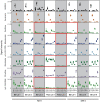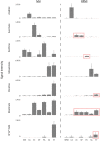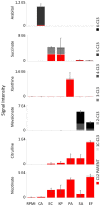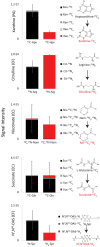Biomarker enrichment medium: A defined medium for metabolomic analysis of microbial pathogens
- PMID: 35935218
- PMCID: PMC9354526
- DOI: 10.3389/fmicb.2022.957158
Biomarker enrichment medium: A defined medium for metabolomic analysis of microbial pathogens
Abstract
Microbes have diverse metabolic capabilities and differences in these phenotypes are critical for differentiating strains, species, and broader taxa of microorganisms. Recent advances in liquid chromatography-mass spectrometry (LC-MS) allow researchers to track the complex combinations of molecules that are taken up by each cell type and to quantify the rates that individual metabolites enter or exit the cells. This metabolomics-based approach allows complex metabolic phenotypes to be captured in a single assay, enables computational models of microbial metabolism to be constructed, and can serve as a diagnostic approach for clinical microbiology. Unfortunately, metabolic phenotypes are directly affected by the molecular composition of the culture medium and many traditional media are subject to molecular-level heterogeneity. Herein, we show that commercially sourced Mueller Hinton (MH) medium, a Clinical and Laboratory Standards Institute (CLSI) approved medium for clinical microbiology, has significant lot-to-lot and supplier-to-supplier variability in the concentrations of individual nutrients. We show that this variability does not affect microbial growth rates but does affect the metabolic phenotypes observed in vitro-including metabolic phenotypes that distinguish six common pathogens. To address this, we used a combination of isotope-labeling, substrate exclusion, and nutritional supplementation experiments using Roswell Park Memorial Institute (RPMI) medium to identify the specific nutrients used by the microbes to produce diagnostic biomarkers, and to formulate a Biomarker Enrichment Medium (BEM) as an alternative to complex undefined media for metabolomics research, clinical diagnostics, antibiotic susceptibility testing, and other applications where the analysis of stable microbial metabolic phenotypes is important.
Keywords: LC-MS; Mueller Hinton; biomarker enrichment medium; biomarkers; metabolomics.
Copyright © 2022 Mapar, Rydzak, Groves and Lewis.
Figures








Similar articles
-
Microbial containment device: A platform for comprehensive analysis of microbial metabolism without sample preparation.Front Microbiol. 2022 Sep 13;13:958785. doi: 10.3389/fmicb.2022.958785. eCollection 2022. Front Microbiol. 2022. PMID: 36177472 Free PMC article.
-
Genetic Determinants Enabling Medium-Dependent Adaptation to Nafcillin in Methicillin-Resistant Staphylococcus aureus.mSystems. 2020 Mar 31;5(2):e00828-19. doi: 10.1128/mSystems.00828-19. mSystems. 2020. PMID: 32234776 Free PMC article.
-
Development of isotope labeling liquid chromatography mass spectrometry for mouse urine metabolomics: quantitative metabolomic study of transgenic mice related to Alzheimer's disease.J Proteome Res. 2014 Oct 3;13(10):4457-69. doi: 10.1021/pr500828v. Epub 2014 Sep 15. J Proteome Res. 2014. PMID: 25164377
-
Candida and candidaemia. Susceptibility and epidemiology.Dan Med J. 2013 Nov;60(11):B4698. Dan Med J. 2013. PMID: 24192246 Review.
-
Mass spectrometric based approaches in urine metabolomics and biomarker discovery.Mass Spectrom Rev. 2017 Mar;36(2):115-134. doi: 10.1002/mas.21455. Epub 2015 Apr 16. Mass Spectrom Rev. 2017. PMID: 25881008 Review.
Cited by
-
HILIC-IM-MS for Simultaneous Lipid and Metabolite Profiling of Bacteria.ACS Meas Sci Au. 2023 Dec 5;4(1):104-116. doi: 10.1021/acsmeasuresciau.3c00051. eCollection 2024 Feb 21. ACS Meas Sci Au. 2023. PMID: 38404491 Free PMC article.
-
Metabolomics strategy for diagnosing urinary tract infections.Nat Commun. 2025 Mar 18;16(1):2658. doi: 10.1038/s41467-025-57765-y. Nat Commun. 2025. PMID: 40102424 Free PMC article.
-
Diagnosis by Volatile Organic Compounds in Exhaled Breath in Exhaled Breath from Patients with Gastric and Colorectal Cancers.Int J Mol Sci. 2022 Dec 21;24(1):129. doi: 10.3390/ijms24010129. Int J Mol Sci. 2022. PMID: 36613569 Free PMC article. Review.
References
-
- Clinical and Laboratory Standards Institute . (2022). M100: Performance Standards for Antimicrobial Susceptibility Testing, 32nd Edn. p. 1–362.
-
- Cocaign-Bousquet M., Garrigues C., Novak L., Lindley N., Loublere P. (1995). Rational development of a simple synthetic medium for the sustained growth of Lactococcus lactis. J. Appl. Bacteriol. 79, 108–116. 10.1111/j.1365-2672.1995.tb03131.x - DOI
LinkOut - more resources
Full Text Sources

